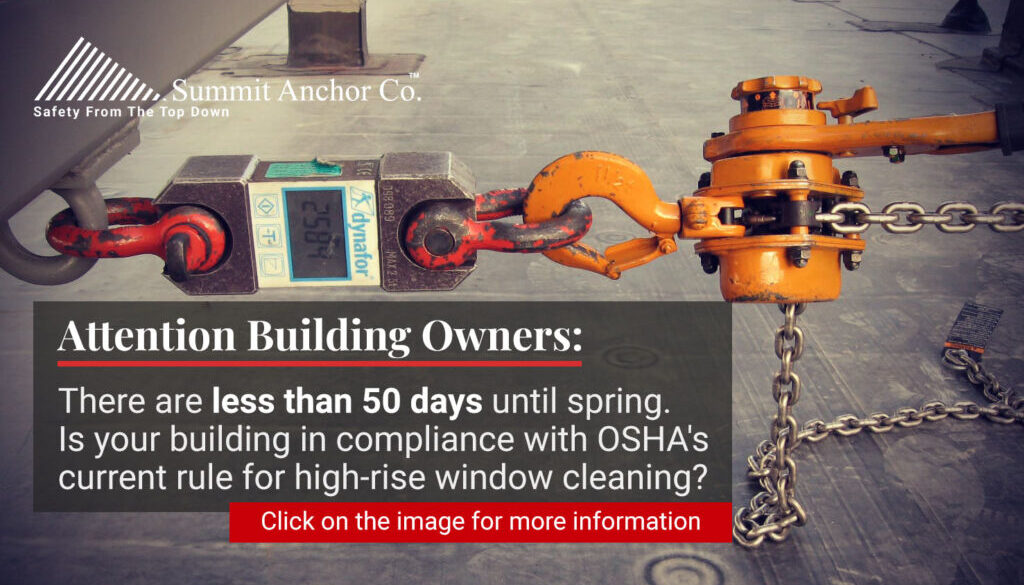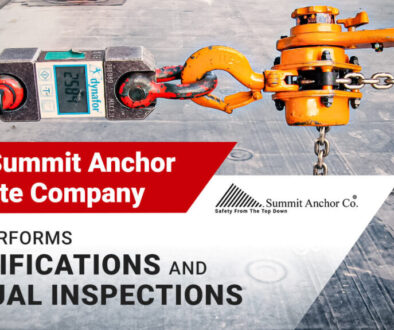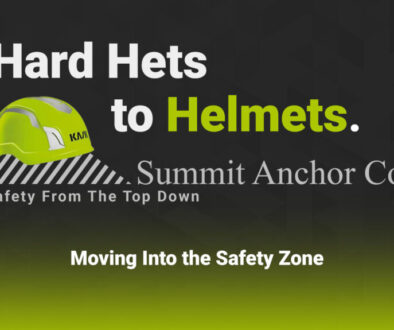Anchorage testing for rope descent systems – what’s required by OSHA & IBC?
By Gus Strats – Summit Anchor Company, Inc. January 27th, 2022
Forward
OSHA published the Walking-Working Surfaces rule on November 18, 2016 in the Federal Register, requiring building owners to inspect and certify permanent anchorages for rope descent systems (RDS) by November 20, 2017.
What is a rope descent system (RDS)?
A Rope Descent System is a non-motorized system that allows the workers to use gravity to control their rate of descent to access the interior and exterior façade of a building. The system’s friction device also allows workers to stop the descent and to remain suspended at any location along their rope to perform their work. By some estimates, 60 to 80 percent of all high-rise window cleaning operations in the United States use RDS.
Anchorage capacity and testing requirements for Rope Descent Systems.
According to the Occupational Safety and Health Administration (OSHA), anchorages used for rope descent systems are required to support 5,000 pounds., per worker attached. Additionally, OSHA says: “the qualified person may utilize any scientifically-valid testing criteria to determine whether an anchorage is capable of supporting at least 5,000 pounds.” Some engineering firms interpret this to mean that certifying anchorages may be performed by methods other than load testing anchorages onsite, while other engineering firms require anchorages to be load-tested up to 5,000 pounds. before they will certify them.
According to the International Building Code, (IBC) 1708.1 General, whenever there is a reasonable doubt as to the stability or load-bearing capacity of a completed building, structure, or portion thereof for the expected loads, an engineering assessment shall be required. The engineering assessment shall involve either a structural analysis or an in-situ load test, or both. The above requirement calls on engineers to use sound judgement and discretion when certifying anchorages. According to our request for clarification to the IBC, “the load test procedure must simulate the actual load conditions to which the structure will be subjected.” Further, according to the IBC, using a design live load of 3,100 pounds (13.8 kN), when combined with a live load factor of 1.6, results in a total factored load of 4,960 pounds. By most engineering standards, this essentially means that anchorages must be tested to a minimum of 3,100 to 4,960 pounds, although opinions vary from engineer to engineer.
According to The ANSI/IWCA I.14 Window Cleaning Safety Standard, 8.1.3 Minimum Inspection and General Testing Criteria: “(b) Designated anchorages, targeted for post-installation testing, shall be tested by applying a minimum static load of twice the design load in each (primary) direction that a load may be applied. For example, an anchorage with an ultimate capacity of 5000 pounds has a four to one safety factor. Therefore, the anchor’s designed load is 1,250 pounds and it shall be tested at 2500 pounds.” It should be emphasized that the I.14 test load criteria is considered a minimum standard of care, not an absolute or maximum test load requirement.
NOTE: ANSI administratively withdrew the ANSI/IWCA I.14 Window Cleaning Safety Standard because the standard had not been revised or reaffirmed by the deadline required.
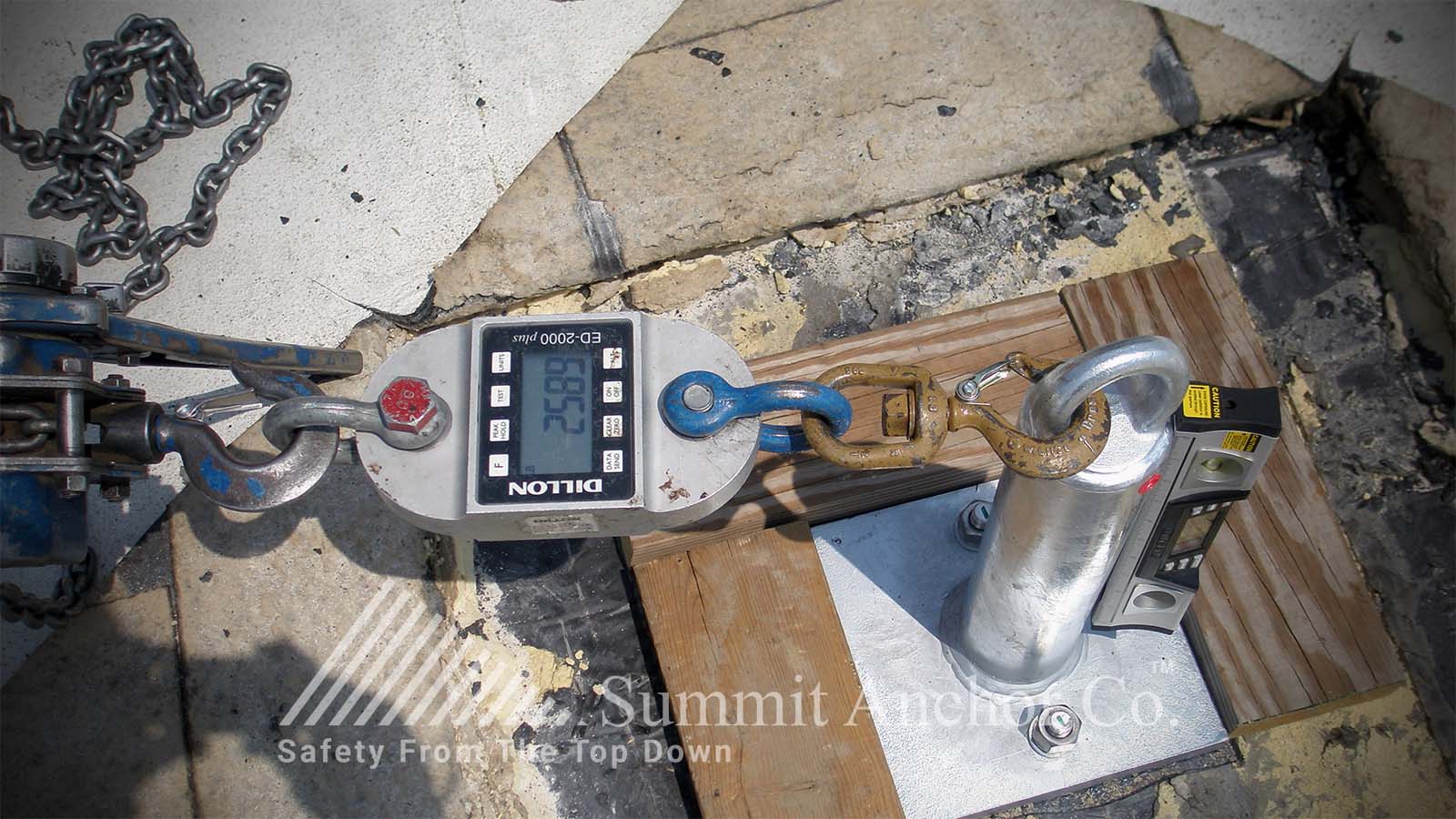
Both OSHA and ANSI-I.14 require two independent anchorages for each worker attached. Anchorage layout requirements are more fully addressed in an anchor layout guide for rope descent systems.
Anchor Layout Manual
What is the Purpose of OSHA?
Congress created the Occupational Safety and Health Administration (OSHA) to ensure safe and healthful working conditions for workers by setting and enforcing standards and by providing training, outreach, education, and assistance.
What is the Purpose of the IBC?
“The International Building Code (IBC) is the foundation of the complete Family of International Codes®. It is an essential tool to preserve public health and safety that provides safeguards from hazards associated with the built environment. It addresses the design and installation of innovative materials that meet or exceed public health and safety goals.”
What is the Purpose of ANSI?
“The American National Standards Institute (ANSI) is a private, non-profit organization that administers and coordinates the U.S. voluntary standards and conformity assessment system. Founded in 1918, the Institute works in close collaboration with stakeholders from industry and government to identify and develop standards- and conformance-based solutions to national and global priorities.”
What is the building owner’s responsibility?
Per OSHA, “Before any rope descent system is used, the building owner must inform the employer, in writing that the building owner has identified, tested, certified, and maintained each anchorage so it is capable of supporting at least 5,000 pounds, in any direction, for each employee attached. This information must be based on an annual inspection by a qualified person and certification of each anchorage by a qualified per, as necessary, and at least every 10 years.”
What is the maintenance contractor’s responsibility?
Per OSHA, “The employer must ensure that no employee uses any anchorage before the employer has obtained written information from the building owner that each anchorage meets the requirements of the above paragraph…”
Who is the ‘Qualified person’ performing the anchorage certification?
According to OSHA standards, “‘Qualified’ describes a person who, by extensive knowledge, training, and experience has successfully demonstrated the ability to solve problems relating to the subject matter, the work, or the project.”
How do OSHA regulations differ from the IBC requirements?
OSHA regulations apply to the employee/employer relationship, whereas, the IBC is a building code that provides minimum requirements to safeguard the public health of new and existing buildings and structures. A new building or renovated part of a building that includes anchorages would be under the IBC, whereas all buildings in the United States where workers use Rope Descent Systems must comply with OSHA.
How do the IBC 2013, 2015, 2018, 2021 impact anchorage requirements?
Requirements for testing anchorages have been in place since the IBC 2015 edition, with some minor changes since then. It is up to states, local agencies and jurisdictions to adopt these codes as they are updated by the IBC. Check with your state or local jurisdiction for more information on what codes may be applicable in your project’s location.
How might directional loading impact an anchorage passing or failing?
OSHA requires the building owner to inform the employer, in writing that the building owner has identified, tested, certified, and maintained each anchorage, in any direction the anchorages may be used. Workers often use anchors in unintended directions, so it is best practice to certify anchorages in any critical or probable directions of use by the worker’s rigging. See an example of failure to certify anchorages for real-world directional use.
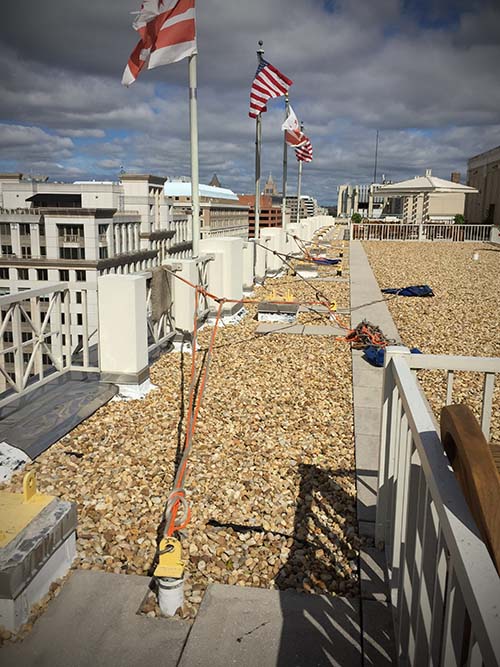
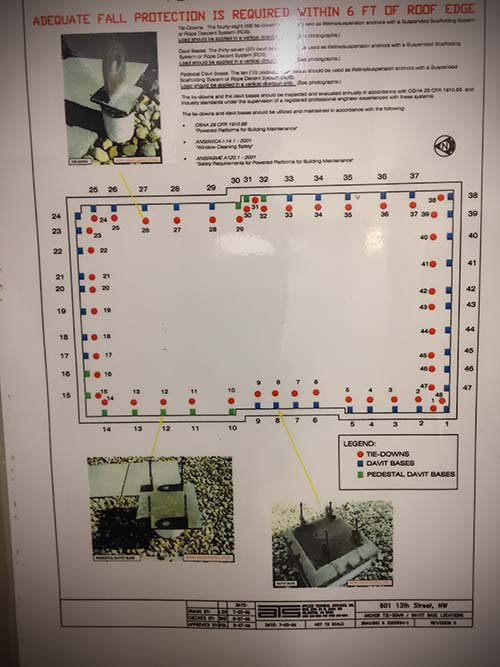
Above anchorages rigged by Rope Descent Workers in horizontal direction, whereas the roof door plan posted on the inside of the roof door said: “load should be applied in the vertical direction only.”
What are the characteristics of various structural elements used for attaching anchorages?
Concrete:
Anchorages attached to concrete should not move when tested under load. This is because concrete is extremely rigid. If any anchorage moves or is displaced under load, this may indicate of a faulty installation, i.e.: the hex nuts were not tightened, the mechanical or adhesive anchor fasteners were not installed per the manufacturer’s installation instructions, etc.
Steel:
Anchorages attached to steel should likewise not move much when tested, if, and this is a big if, the connection detail with requisite bracing has been properly designed to withstand the test loads and was correctly installed on site. If the design or installation is flawed, the anchorages including the steel member the anchorage is attached to may deflect under load in various directions. Anchorages are typically weaker when loaded perpendicular as opposed to in-line with the structural member the anchorage is attached to, especially if no additional bracing was added to resist those perpendicular loads. Steel’s ductile properties means that steel members may temporarily deflect or permanently deform if not designed and installed properly when an anchorage is test loaded.
Wood:
Anchorages that rely on wood members for support are some of the most difficult anchorages to professionally design due to the: 1) inherently nonuniform properties of wood, 2) the required design load, and 3) designing the connections to resist the design loads in all directions of probable use.
Note: Excessive deflection or deformation of any anchorage attached to any structure under load may indicate that the anchorage was not designed to withstand the required OSHA and/or IBC load capacity.
Conclusion
OSHA requires building owners to inform the employer in writing that each anchorage can support at least 5,000 pounds, in any direction the anchorages may be used. That requirement with all the above-mentioned variables gives the building managers and/or owners compelling reasons to investigate and to confirm that their engineering firm and/or contractor is aligned with the owner’s tolerance for, or aversion to risk.
